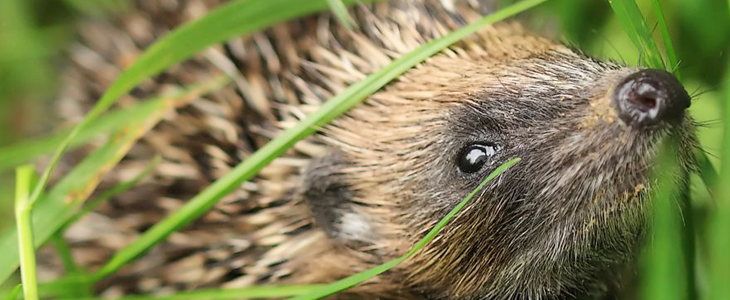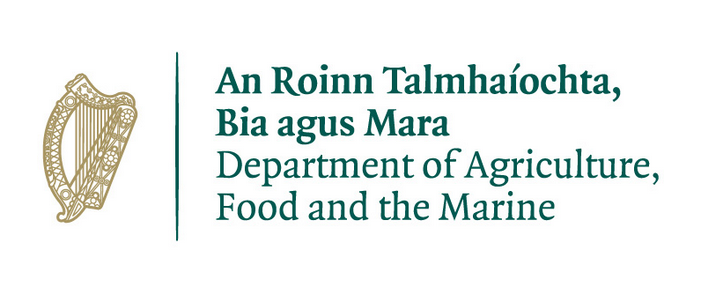
Hedgehog
Hedgehog - Erinaceus europaeus
Hedgehogs are easily recognisable due to their small size (about 25cm long) and their distinctive sharp spines. They are nocturnal animals and therefore if you see one during the day this may be a sign of illness. They are omnivores who eat insects, such as beetles, caterpillars, earthworms, slugs and will also feed on fungi and fruits. As they consume a number of plant pests, hedgehogs are beneficial to gardeners and farmers.
It is not known when the hedgehog arrived in Ireland. It is believed that it was probably introduced by humans, possible as a source of food. It can now be found throughout the country. As landscape conditions have changed over the years, they have moved from their preferred habitat (woodlands and open grasslands) to hedgerows and residential gardens. During colder months (October – March) they will hibernate in nests of grass, leaves and dried vegetation. Although some will hibernate for the entire period, most will wake during milder weather to forage and change nest.
Although there is no reliable data on hedgehog abundance in Ireland, there is strong anecdotal evidence suggesting a similar population trend to that occurring in Great Britain, where a study showed a decline in hedgehog numbers over the past 50 years. This decline correlates strongly with changing and increasingly intensive land use over that period.
Hedgehogs have few natural predators in Ireland, however, accidental road deaths account for a large portion of hedgehog deaths, especially at night while they are foraging. A study into the age of hedgehog deaths in Ireland found that 54% of hedgehogs, killed on roads, were less than one year old.
Hedgehog Crimes
The Hedgehog is protected by law in the Republic of Ireland under the Wildlife Acts 1976 to 2012 and is listed in the Bern Convention (Appendix III) as a species requiring protection.
Unless authorised to do so under a valid licence/permission granted by the Minister for Arts, Heritage and the Gaeltacht under the Wildlife Acts 1976 to 2012 it is unlawful to:-
- Hunt, kill or injure a hedgehog
- Wilfully interfere with or destroy the breeding or resting place of a hedgehog
- Be in possession of a hedgehog, whether alive or dead, or any part, product or derivative thereof other than one lawfully taken pursuant to the Wildlife Acts
- Sell, keep or offer for sale, or engage in taxidermy in respect of a hedgehog or any parts, products or derivative thereof, other than by a licensed wildlife dealer with a lawfully acquired specimen
ACCIDENTAL TRAPPINGS
Hedgehogs will come to our gardens to forage for food, so care should be taken for their safety when they visit. They can often drown in garden ponds where the design prevents them from climbing back out of. They are vulnerable to pesticide use in gardens. They can get entangled in tennis and goalpost nets. Garden strimmers can inflect terrible injuries on hedgehogs. They may accidentally become trapped in everyday household objects, such as, tin cans, yoghurt pots, and plastic can holders. This can lead to a slow and painful death. It is therefore important to dispose of household waste correctly. They often fall victim to cattle grids, but fitting a ramp allows a trapped hedgehog to scramble free.
KEEPING HEDGEHOGS
Aside from accidental trappings some hedgehogs are trapped to be kept as pets. As hedgehogs are protected by Irish law, they may not be kept captive and to do so is a crime. Hedgehogs can however take up residence in our gardens if they find the habitat to their liking. Hedge bottoms provide food and cover for then and should not be raked out too often. The odd pile of leaves in a secluded corner or behind the garden shed can be ideal for nesting and hibernating sites.
INJURED HEDGEHOGS
Sick or injured hedgehog may be kept captive for a period of recuperation once granted a licence from the National Parks and Wildlife Service. If you need to handle a hedgehog for any reason, they should always be handled with gloves.
Wildlife Licensing Unit,
National Parks and Wildlife Service,
Department of Housing, Local Government and Heritage
National Parks and Wildlife Service
90 King Street North
Dublin 7
D07 N7CV
Email: wildlifelicence@npws.gov.ie
Call: 01 888 2000
Recording evidence at the Crime Scene
Assessing whether a criminal offence has taken place may not always be straight forward and other possibilities such as natural deaths, predation and legal hunting should be considered.
If you come across a wildlife crime scene or a dead bird or object that may be related to a wildlife crime, every piece of information is – or might be – important, but it needs to be recorded properly and accurately for the authorities to have a chance of prosecuting an offender.
Before you do anything else it is very important that:
- You do NOT put yourself in danger by approaching anyone you suspect of committing a crime – they may be violent and/or aggressive.
- You do NOT touch any dead birds or animals. They may be poisoned baits or victims of poisoning. Many poisons (e.g. Carbofuran) are extremely dangerous to us as well as wildlife in even very small amounts and can be absorbed through the skin.
- You do NOT disturb the scene by walking around unnecessarily – small pieces of evidence (cigarette ends, footprints, the marks left by a spade etc) may be lost or trampled into the mud or grass.
- You do NOT move any items at the scene – unless asked to do so or an animal or human”s welfare is/may be compromised by leaving it at the scene.
- You do NOT mark the site (e.g. with a white plastic bag) Although being able to see a marker from a distance might sound like a good idea, it will also alert an offender that someone has been at the site and they might go back and remove evidence.
- You do NOT do anything illegal yourself – leave crime to the criminals!
Record the date and time
- Record the transport
Do this as soon as possible, as suspects can be traced from the registration number
Photograph/write down any vehicle registration numbers that are or might be related to the incident. It is legal to record a registration number if you suspect that the vehicle has been or may be used in a crime. - Record the person
Recording the offender’s face is important of course, but their clothing, the bags they’re carrying, the equipment they’re using are all important too. - Record the scene
Take photographs or video of the scene using a mobile phone or camera etc (or make as accurate a sketch as possible). - If possible try to cover any items, perhaps with vegetation, to make them safe; but make sure you don’t disturb the crime scene in the process!
- If photographing an object, try to put something beside it for scale (e.g. a coin or notebook) providing it won’t disturb the crime scene.
- Record the location
It is particularly important to record locations accurately (apps that provide GPS data are available for most smartphones)
In an urban area note the address or a description of the location. In the countryside take wide angle photographs of any landmarks; a tree, a distinctive fence line, a hill. - Even if in doubt take a photograph and email it to the National Parks and Wildlife Service WildlifeEnforcement@npws.gov.ie
Reporting a hedgehog crime
To report suspected illegal hedgehog activity contact the National Parks & Wildlife Service
Tel: (01) 888 2000
Contact numbers for your local NPWS Conservation Ranger HERE
If you can’t reach NPWS personnel call An Garda Síochána:
If the crime is in progress or about to happen, or if the offender is still at the scene or has just left call 999 or 112
If the event is finished then contact the National Bureau of Criminal Investigation on envi.wildlife.crime@garda.ie and call your local Garda Station (Garda Stations Directory) or the Garda Confidential Telephone Number 1800 666 111
[Although it will assist the NPWS and Gardaí if you provide as much information as possible, you do not have to give your name if you ring to report an incident.]
| If the hedgehog is alive and is injured, also call a wildlife rehabilitator/vet from the contacts page of Irish Wildlife Matters website | Irish Wildlife Matters |
